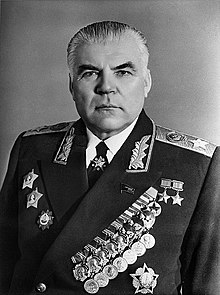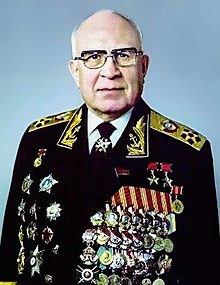K-3 Leninsky Komsomol
|
K-3, project 627
|
||||||||||||||||||||
|
||||||||||||||||||||
|
||||||||||||||||||||
|
||||||||||||||||||||
|
||||||||||||||||||||
|
||||||||||||||||||||
The K-3 Leninsky Komsomol (Ленинский Комсомол) was the first nuclear-powered submarine of the Soviet Union . The type it was a project 627 "Кит" ( Russian "kit" means whale) and the prototype of the submarine generation known in the West as the November class . Due to its historical position, the submarine was the only one to have a name in contrast to the tactical numbers of all other Soviet makes.
background
With the detonation of its own, albeit copied, atomic bomb in 1949, the Soviet Union reacted to the USA's technical lead in nuclear armament. The physicist Igor Kurchatov had the idea of a transport reactor back in 1950. The public keel laying of the first American nuclear powered submarine took place in June 1952. On September 12 of the same year, Stalin signed a government decree entitled "On the Design and Construction of Object 627". Vladimir Peregudov's design office was in charge of the planning . Anatoly Alexandrov was named as the scientific director .
development
In the initial phase of development, four reactor options were considered: a uranium-graphite reactor (similar to the reactor of the world's first commercial nuclear power plant Obninsk ), an option with a moderator made of beryllium oxide, one with a liquid metal coolant and a water-water reactor , in which water acts as a neutron moderator and coolant of the first cycle - the latter was then also used. At K-3, the hull was redesigned from scratch, with a focus on optimizing underwater travel. The general layout of the boat was influenced by the experience of Project 611 .
Construction and commissioning
The submarine was built in the Sevmasch shipyard in the restricted area of Severodvinsk , then still known as Molotovsk, near Arkhangelsk on the White Sea . On August 9, 1957, the submarine was put into operation. On May 19, 1958, high-ranking officials started the reactor together at the dry dock, including Defense Minister Dmitri Ustinow , Admiral Sergei Gorshkov , who was later known as the “father of the Soviet nuclear submarines”, and Boris Butoma , Minister for the Shipbuilding Industry . On July 1, 1958, the submarine was in service with the Northern Fleet.
The K-3 entered service as part of the Northern Fleet under Commander Leonid Ossipenko . The Executive Officer Lew Schilzow put together the first team.
deployment
The submarine was then stationed in the climatically inhospitable far north in the fjord Sapadnaja Liza on the Kola peninsula - Malaja Lopatka served as a base , about 45 kilometers from the Norwegian border. The base was supplied by the city of Saozjorsk, which was founded for this purpose . In total, the submarine undertook 14 longer mission trips.
Advantages and weaknesses
The K-3 had two nuclear reactors , two steam turbines and two screws. Water was used as the heat transfer medium or coolant for the reactors, since compact dimensions and operational reliability were key requirements. The thermal energy of the reactors was supplied via heat exchangers and steam generators to two steam turbines with a total output of 35,000 hp, which, via the gear system, drove two propeller shafts with screws and an electric generator to generate electricity. As armament, it did not yet have missiles, but eight torpedo tubes with an ammunition supply of 20 torpedoes. The hull was slim and designed for high speeds.
During the first test drives, a submerged depth of 310 meters, which was previously unattainable by Soviet submarines, was achieved. The speeds already driven during the factory tests were higher than expected and, together with the long diving times and the practically unlimited driving range, gave the submarine tactical properties that could not be achieved by conventional submarines.
One problem, however, was the high level of radioactivity released . After a few hundred hours of operation, microscopic cracks formed in the primary circuit of the cooling water and polluted the secondary circuit and ultimately the entire team with radiation. The resulting radiation sickness of the crew was largely ignored and underestimated. Compared to later generations of submarines, the submarine had practically no noise insulation and was therefore very easy to locate, especially at high speed. In general, the K-3 was considered technically immature and, against the background of the arms race with the USA, as a weapon system that was put into service too early. The submarine was prone to breakdowns and dangerous during operation. The short service life of the steam generator forced the boat to carry out repairs for a long time. Emergency plans in the event of reactor failure or other serious incidents were of secondary importance.
During the Cuban Missile Crisis in 1962, only the reliable diesel-electric boats were in use. The immediate next make of the class, the K-8 , became the first nuclear submarine to sink in 1970 in the Bay of Biscay, 800 km off the coast of France.
North Pole Travel and the Military-Political Dimension
On June 17, 1962, the K-3 reached the North Pole underwater - a feat of engineering that had been achieved almost four years earlier by the first US nuclear submarine, the USS Nautilus . The submarine was also able to surface directly at the pole, which the USS Skate had previously done. With this dive, the Soviet Union demonstrated the military potential of being able to invisibly attack the USA under the ice sheet of the Arctic . The crew was personally received by party leader Nikita Khrushchev , accompanied by Defense Minister Rodion Malinovsky , who inspected the shipbuilding plant in Severodvinsk. To honor this pioneering achievement, the submarine was named Ленинский Комсомол ( Leninsky Komsomol ) on October 9, 1962 . The celebrated team then took part in numerous congresses and conferences. The leading people, including Lev Schilzow, were awarded the highest honors. Among the creators of K-3, 19 received the Lenin Prize . The Soviet Navy was heavily dependent on its few ports located far to the north and largely ice-free in winter. This gave the K-3 and the submarines based on this technology of strategic importance in national security policy. At the same time, the Leninsky Komsomol was a starting point for the evolving balance of terror and arms race , which took place particularly in the 1970s and 1980s with nuclear submarines. Admiral Gorshkov was the driving force and father of the Soviet nuclear submarine fleet.
In June 1962, a fire damaged the boat's nuclear reactor, causing it to be towed. The difficult repair took several years.
Mission in the Mediterranean
In the summer of 1967, after a long period of repairs, the K-3 got a new commander and the mission to cruise in the Mediterranean . The political background was the outbreak of the Six Day War in the Middle East in June 1967. The cooling system failed to a large extent and exposed the crew to extreme heat loads. The task was also set to track an American submarine with ICBMs , but this did not succeed.
Serious accident in 1967 and its consequences
On September 8, 1967, there was a serious accident in the sea off Norway , in which 39 men were killed in a fire. The ship was 2,850 kilometers from its home port, had already been on the move for 56 days and came back from a dive under the Arctic ice. The fire was caused by inflamed hydraulic fluid in compartments 1 and 2. Numerous men were killed by the carbon dioxide from the automatically triggered fire extinguishers and the closing of the bulkheads . The submarine itself was finally saved. On the part of Admiral Gorshkov, the crew was blamed and an allegedly found cigarette was listed as evidence. However, the course of the accident remained controversial; Only decades later was the crew acquitted and the replacement of a high-quality seal for an inferior one determined as the cause of the accident.
The use of the submarine was then restricted. In 1988 the K-3 was declared a "training submarine" and in 1991 it was decommissioned. During its approximately 30 years of service, the K-3 covered more than 206,708 km in 14 long-term patrols.
In 1991 a memorial for the victims was erected in Malaja Lopatka, the former home port of the submarine.
Present position
The reactor room of "K-3" was dismantled in 2007 and stored in Sajda Bay in the Murmansk region . The Russian nuclear holding company Rosatom created a replica of the reactor room . The submarine should be restored. The renovation work on the boat was completed on March 19, 2019. All outboard openings were welded. The boat is moored in the water area of the Nerpa shipyard in Snezhnogorsk , 25 km from Murmansk. Since August 20, 2019, it has been waiting for a financing decision for the conversion into a museum ship. St. Petersburg was named as the final position , in the vicinity of the Aurora .
literature
- Leonid G. Ossipenko, Lew M. Schilzow, Nikolai Mormul : Atomnaja podvodnaja epopeja. (The Underwater Nuclear Era.) Moscow 1994, ISBN 5856900073 .
- Alexei Wasiljewitsch Aprelkow, LA Popow: Is morskich glubin: k istorii podwodnich lodok "Tscheljabinski komsomolez" i "Leninski komsomol". Tscheljabinski obl.soviet veteranow woiny, truda, wooruschennych sil i prawoochranitelnych organow, Tscheljabinsk 1996, ISBN 5713500934 .
- Thomas Nilsen, Igor Kudrik, Aleksandr Nikitin: Bellona Report 1: The Russian Northern Fleet. The Bellona Foundation, August 28, 1996, section 4.3.
- Norman Polmar, Jurrien Noot: Submarines Of The Russian and Soviet Navies: 1718–1990. Naval Institute Press, 1991, ISBN 9780870215704 .
Movies
- The Hollywood film K-19 - Showdown in the Depth , made in 2002, shows largely authentically the conditions on a Soviet nuclear submarine, which was technically based on the K-3 and operated around the same time. Analogies can be found in the area of tension between the loss of human life in favor of saving military technology. The film also addresses the organizational and technical deficiencies beyond official, political propaganda.
- The Russian three-part documentary The Russian Depth (2001) by Alexander Maximenko and producer Alexander Wiktorow contains numerous recordings and historical details of the K-3 and other early nuclear submarines of the Soviet Union.
See also
Web links
- Former page from submarine.id.ru with numerous photos about K-3 ( Memento from May 14, 2011 in the Internet Archive )
- Former page from submarine.id.ru to K-3 ( Memento from May 14, 2011 in the Internet Archive )
- Triumph and tragedy of the Leninsky Komsomol on flot.com (Russian)
Individual evidence
- ↑ Alexander Antonow, Walerie Marinin, Nikolai Walujew: Soviet-Russian nuclear submarines. Brandenburgisches Verlagshaus, Berlin 1998, ISBN 3-89488-121-6 , pp. 9-20.
- ^ History of the development of submarines. Collection of articles created by the designer, Vlasov Vitaly Petrovich, Yekaterinburg, 2003 (Russian)
- ↑ Overview on rusnavy.com
- ^ Peter Lobner: Marine Nuclear Power 1939-2018. 2018. p. 107.
- ↑ Documentation: K-3. The first nuclear submarine. TV channel "Star", tvzvezda.ru. 2019 (Russian).
- ↑ The conversion of the Leninsky Komsomol nuclear submarine into a museum is delayed. In: Information Agency severopost.ru, August 20, 2019 (Russian).




